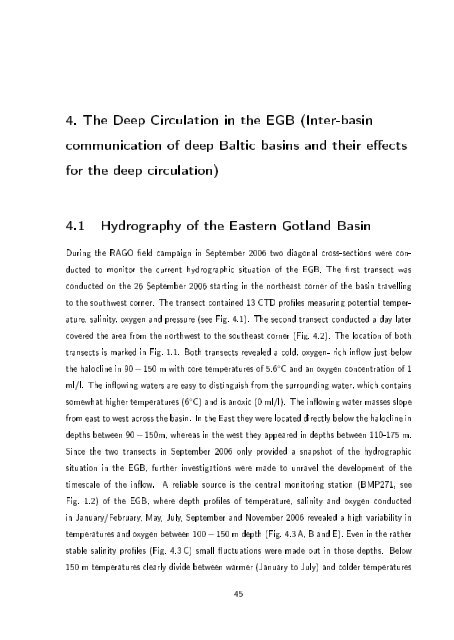Baltic Sea
Baltic Sea
Baltic Sea
Create successful ePaper yourself
Turn your PDF publications into a flip-book with our unique Google optimized e-Paper software.
4. The Deep Circulation in the EGB (Inter-basin<br />
communication of deep <strong>Baltic</strong> basins and their eects<br />
for the deep circulation)<br />
4.1 Hydrography of the Eastern Gotland Basin<br />
During the RAGO eld campaign in September 2006 two diagonal cross-sections were conducted<br />
to monitor the current hydrographic situation of the EGB. The rst transect was<br />
conducted on the 26 September 2006 starting in the northeast corner of the basin travelling<br />
to the southwest corner. The transect contained 13 CTD proles measuring potential temperature,<br />
salinity, oxygen and pressure (see Fig. 4.1). The second transect conducted a day later<br />
covered the area from the northwest to the southeast corner (Fig. 4.2). The location of both<br />
transects is marked in Fig. 1.1. Both transects revealed a cold, oxygen- rich inow just below<br />
the halocline in 90 − 150 m with core temperatures of 5.6 ◦ C and an oxygen concentration of 1<br />
ml/l. The inowing waters are easy to distinguish from the surrounding water, which contains<br />
somewhat higher temperatures (6 ◦ C) and is anoxic (0 ml/l). The inowing water masses slope<br />
from east to west across the basin. In the East they were located directly below the halocline in<br />
depths between 90 − 150m, whereas in the west they appeared in depths between 110-175 m.<br />
Since the two transects in September 2006 only provided a snapshot of the hydrographic<br />
situation in the EGB, further investigations were made to unravel the development of the<br />
timescale of the inow. A reliable source is the central monitoring station (BMP271, see<br />
Fig. 1.2) of the EGB, where depth proles of temperature, salinity and oxygen conducted<br />
in January/February, May, July, September and November 2006 revealed a high variability in<br />
temperatures and oxygen between 100 − 150 m depth (Fig. 4.3 A, B and E). Even in the rather<br />
stable salinity proles (Fig. 4.3 C) small uctuations were made out in those depths. Below<br />
150 m temperatures clearly divide between warmer (January to July) and colder temperatures<br />
45



